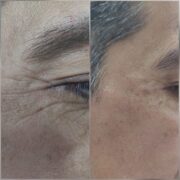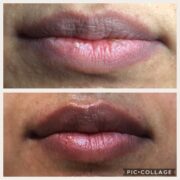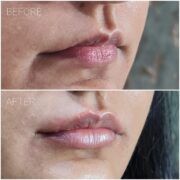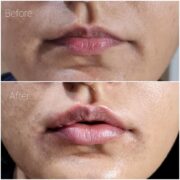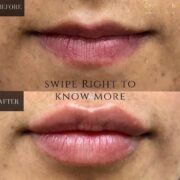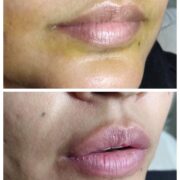
What are dermal fillers and how can they help you to enhance your looks?
Dermal Fillers are a type of non-surgical cosmetic procedure. Dermal filler injections are substances used to enhance the appearance of facial wrinkles, smooth lines, and creases by restoring volume and plumping them up. They’re also used to fill in scars and other imperfections on your skin. In some cases, dermal fillers can even be used to reduce the appearance of acne scars.
This treatment hardly takes time, from a few minutes to an hour, depending on the area to be treated. Even the recovery time is minimal in this procedure. Results can be seen immediately and last up to months or years depending on the type of filler used and the treated area.There are several options available if you decide to undergo the dermal filler procedure. Your healthcare provider will discuss and suggest the best option available as per your needs and requirements.
Why are dermal fillers used?
With age, your body starts to lose collagen, which is a vital substance present all over your body's skin, muscles, bones, and connective tissues. When the amount of collagen in your skin decreases, it causes skin laxity and loss of volume. As the skin becomes thinner and loses its elasticity, it starts to sag.
Dermal Fillers can help you :
- >Add volume to your skin
- >Plumps up lips and cheeks
- Smoothen the wrinkles on your face
- Makes your facial features more symmetrical
Who is a candidate for dermal fillers?
People are highly choosing dermal fillers these days, as it improves your facial features or helps you gain a youthful appearance. It is a fast and affordable way to slim your features or restore volume that has gradually faded over the years. For example, if you’re in your 50s and wish to look younger you have to start now.
Dermal fillers are used by people of all ages, but they’re most commonly used in the following cases:
- Acne scars that are unable to respond to other treatments
- Wrinkles and/or fine lines around the eyes, mouth, and forehead
- Loose skin due to weight loss or malnutrition
- Children with congenital skin conditions, such as birthmarks or port-wine stains
Which are the different facial areas where dermal filler treatment is done?
When it comes to dermal filler treatment, there are multiple areas on the face where these substances can be used.
The areas include the nasolabial folds (vertical lines between the nose and mouth), the corners of the mouth, the chin, the jawline, the forehead, and the cheeks. For the best results, dermal filler treatments are usually done in multiple areas at the same time.
filler treatments are also done in other parts of the body, including the lips, cheeks, arms, and abdomen.
What are the types of dermal fillers?
- Hyaluronic acid: This is used most commonly to reduce the appearance of wrinkles.
- Bovine collagen: Collagen is the protein in our bodies that supports the skin's elasticity. Bovine collagen is the same type that is used to make bone. It's used to tighten skin and reduce wrinkles.
- Autologous fat: This is harvested from the patient's own liposuction and is used to restore volume to the lips.
- Silicone: This is silicone oil and is used to fill in scars, stretch marks, and other skin imperfections.
- Collagen-rich dermal scaffolds: A collagen-rich dermal scaffold is a material made of human-derived collagen that can be used to restore volume to the face.
How do we walk you through the process of dermal filler treatment?
Our consultation process
Our healthcare provider examines your face and skin and understands your reason for undergoing filler treatment. They then recommend a specific type of filler according to the area you would like to get treated and enhanced. They also review and inform you of the possible side effects and the recovery time. They also ask about your medical history, to reduce the risk of complications during and after getting fillers.
You are advised to inform your healthcare provider if you have:
- Allergies
- History of bruising or bleeding
- Neurological problems
What happens during dermal filler treatment?
Our healthcare provider cleans your skin and applies anaesthetic lotion or cream. The anaesthetic numbs the skin area to be treated, which makes the procedure a painless experience for you. A thin needle is used by the healthcare provider to inject small amounts of fillers under your skin. You may not experience much pain during these injections. The complete process may take a few minutes or up to an hour depending on the area of treatment.
What happens after dermal filler treatment?
Our healthcare provider cleanses your skin and helps you ease out the pain and swelling by providing you with an ice pack. You may get a little swelling, bruises, or some discomfort after getting the filler injections. But this is just a temporary effect and the side effects go away in a few days.
Benefits of dermal filler treatments
- Dermal fillers can help you look and feel younger.
- May also improve your self-confidence and self-esteem by giving you a more youthful appearance.
- It can create a more even skin tone, which can help reduce the appearance of dark spots, hyperpigmentation patches, and acne scars.
Side Effects of dermal filler treatment
There are also some side effects that you should be aware of. These include:
- Bruising and/or bleeding: Any bruising or bleeding that occurs after the procedure is likely a result of too-rapid skin tightening. If this occurs, you should stop using dermal fillers until the skin heals.
- Scarring: If a scar appears in the place where dermal filler was applied, it’s possible to have it surgically removed.
- Infection: A small possibility exists that dermal filler can cause an infection. If this occurs, you should see a doctor immediately.
- Dropping or sagging: If your face starts to sag more than usual, it’s likely that too much filler has been injected into the skin. You should see a doctor immediately to have the excess filler removed.
Who should avoid dermal filler treatment?
There are some people who should avoid dermal filler treatment. These include–
- People who are allergy-prone, as many dermal fillers contain allergens, such as animal products.
- People with active infections, as dermal filler can delay healing.
- Individuals who are taking blood-thinning medications, as these medicines can affect the results of dermal filler treatment.
Why should you choose GarekarMD as your facial filler specialist?
If you think facial fillers may be right for you, GarekarMD invites you to meet with our team for a no-risk consultation. Here, we evaluate your facial features and structure and guide you with the best treatment as per your goals and needs. We are happy to answer all your questions and help you clear all your doubts about the treatment procedure. Our experienced healthcare providers are eager to welcome you to our clinic with advanced facilities to begin your journey to a more beautiful you.






